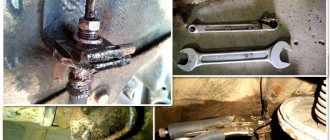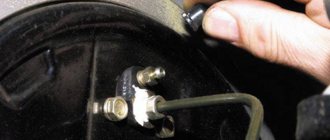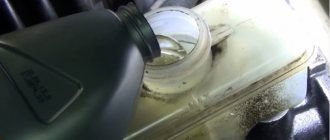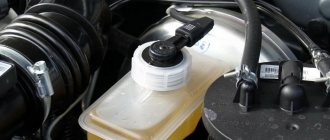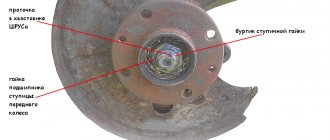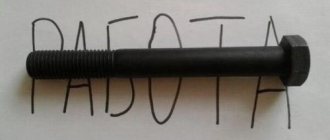After long periods of operation and considerable mileage, the car will most likely need to dismantle some parts of the brake system, which is associated with unscrewing the union tubular nuts at the ends of the brake pipes. Over time, this becomes difficult to accomplish due to souring of the thread. If the tube needs to be replaced and there is no need to save it, the mating part can be expensive and is in working condition. We have to look for a way to safely unscrew the tube fasteners.
How to get home if the brake pipe bursts. manipulator Nissan diesel
I started to put everything together when the brake pipe burst. Well, nothing, it was lying somewhere in stock, I began to slowly unscrew it when the brake line burst a little further on.
On the road, the brake pipe burst, and every time the brake pedal was pressed, the fluid leaked out... It was decided to plug the brake pipe - but alas, in vain! Because the pressure is too high, and the tube is rusty..! Another solution turned out to be more practical. Having removed the brake fluid supply hose from the reservoir to the pg, we turn off the rubber hose by inserting a 10mm bolt into it. and tighten it with a clamp so that the bolt does not fly out. And that’s it, you can drive, but carefully, keeping your distance because... The rear brakes don't hold up. PS God forbid that you don’t need this... but maybe it will help someone..!
When is it time to change tubes?
Signs you should be looking for a flaring kit include:
- During emergency braking, when you press the pedal, a very characteristic creaking sound is heard;
- Under the same outgoing conditions, a rhythmic vibration is felt;
- The braking distance of your car is noticeably longer;
- The brake pedal travel becomes freer, it seems to be dangling;
- Brake fluid may leak (this is especially noticeable when the car is parked overnight for a sufficiently long time);
- Significant overheating of the brake drums and premature uneven wear of the pads are often observed;
- Indirect symptoms include the car pulling to the side while driving in a straight line.
Has the brake pedal become wobbly? Broken brake hose? There is a solution!
It just so happens that instead of notes about the desired tuning and modifications to my bus, my entire BZ is filled with articles about repairs. This time there was another breakdown, the rear brake pipe burst. The breakdown could not be repaired immediately, as it burst almost behind the tank. I turned off the circuit on the rear right wheel and drove it like that for 3-4 months. Yes, it’s true that safety comes first, but the car runs every day and there was no time for repairs. Fortunately, the completed technical inspection came to my aid, and I can’t drive without it. The New Year holidays passed, and then I found time to repair my bus. What to do if your brake hose suddenly bursts?
Flaring machine
Of course, if the pipes are faulty, you can take the car to a service station and entrust the repair to specialists. But why spend money on something you can do yourself? To do this, you need to purchase a flaring tool in specialized stores or order it online. It is available for inch or metric threads. The set includes a pipe cutter, a device, pliers, a clamp, and dies for different diameters of tubes for flaring with a fungus.
When purchasing a tool, you should pay attention to the manufacturer and cost. It is better not to buy the cheapest sets, as their quality is not conducive to long-term use. This repair method is less expensive than in a car repair shop, and relatively easy.
Do-it-yourself repair of a rotten brake pipe.
There is one nuance here, the whole point is that you may not have a steel ball at hand; in this situation, you can make a lead ball (if you are a fisherman, you probably carry fishing accessories). You can create something like a ball from cigarette foil. In general, how you will make this same ball is up to everyone, but it will need to be tightly hammered into the vacated hole in the master brake cylinder. Once the ball is hammered into the brake cylinder, you can tighten the brake pipe.
In this video I will tell you in detail how to easily repair a rotten brake pipe. As usual, the pipes rot in the rear of the car and previously it was necessary to replace the entire length of the brake pipe. But I will tell and show, using the example of my car, a 1997 Ford Mondeo 1.8 petrol hatchback, how you can fix a problem like a brake fluid leak for two euros and fifty cents (2.50 euro.). I think everyone can handle this after watching this video. Enjoy watching.
Flaring and its details
Often the main body in the brake tube remains intact, but the structure of its 6-sided head is destroyed. There may be other options: coking of threaded connections as a result of liquid getting on them, clogging them, etc. In such situations, if the length allows, you can simply cut off the defective part. But it is better to replace the tube completely if you are planning to carry out such a repair. In addition to the flaring machine, you will need pliers, a pipe cutter, a fitting and a drill. Materials: a little acetone.
- The required piece of tube is cut with a pipe cutter;
- It is clamped with a holder so that the edge protrudes 5-6 millimeters beyond it;
- Instead of a cone, a stamp is placed that corresponds in cross-section to the tube (both the holes in the holder and the stamps in the flaring device are from 5 to 8, so it is not difficult to select the desired size);
- The inner edge of the tube is cleaned with something sharp; an ordinary knife will do;
- The end is slightly straightened with a file;
- The fitting is put on exactly at this moment, since later it will no longer be possible to tighten it. The thread of the nut should be directed towards the end of the tube, not towards its body;
- The stamp is screwed in, flattening the end of the tube. The main thing here is not to overdo it and not to flatten it too deeply;
- The next step is not necessary - the European fastening standard has been met. However, the American standard, also called double cone, is considered more reliable. If you're looking for strength, get started. The stamp is removed; a cone is placed instead. It must be screwed in gradually, carefully and without distortion;
- The result should be a tube ringed with a nut with a smooth mushroom-holder at the end, if you stopped at step 7, or a recess in the cap, if you went further;
- The finished tube is installed in place of the failed one, brake fluid is poured into the system, then passed through it. The vehicle and system are checked for the absence of the above-described signs of problems.
Having figured out how to flare a brake pipe with your own hands, provide yourself with a minimum of such work in the future: place the copper one in the designated place. We assure you: you will have to remember about flaring much less often. Even with very intensive use of the machine, you will not need it before 2-3 years.
Hello to all DIY lovers. In this article I will talk about how to make rolling for brake pipes with your own hands. This device will be useful for those who service their car themselves and will help in repairing the brake system.
Before reading the article, I suggest watching a video that clearly shows the assembly process of this device, as well as testing it in real conditions.
In order to make rolling for brake pipes with your own hands, you will need:
* Bench vice * Angle grinder, cutting and grinding wheel * Metal corner measuring 100 mm * Metal plate 6 mm thick * Metal drill with a diameter of 4.5 mm, 6 mm, 10 mm * Bolt from the car hub * Welding machine, leggings, welding machine mask * Safety glasses, gloves, headphones * Copper tube with a diameter of 5 mm * Metal lathe, equipment * Tap with M6 and M12 threads * Matte spray paint * Electric drill
Step one.
Clamp a metal corner measuring 100 mm in a vice and, using a ruler and pencil, make markings along which the workpiece will need to be sawed off.
Replacing brake pipes. Important points!
But to be honest, there was a situation: I waited until the ordered parts were delivered, during which time I turned off the brakes of both rear wheels and drove CAREFULLY for a week. Both wheels need to be turned off (although I also had a problem with the right rear). Replacing brake pipes. Useful tips! https://youtu.be/UNJteTLdH5Q In this video I tried to tell and give some useful tips on replacing brake pipes using the Passat B3 car as an example. But all this applies to other cars. Let me remind you that you should not wait for the brake pipe to become very rusty and burst. Inspect the brake pipes in a timely manner and replace them with new ones if required. Do not wait for the brake pipe to burst at the “hour X”.
Estima, Emina, Luc >(automatic transmission, manual transmission, transfer case, cardans, gearboxes, axle shafts, CV joint)
Post by Dariy » 18 Sep 2012, 20:48
Post by brembist » Sep 18, 2012, 8:56 pm
Post by Dariy » 18 Sep 2012, 21:30
Is it unacceptable even temporarily? I plugged it with a toothpick, covered it with superglue and liquid nails and went to the city to look for the pipe.. I rode around for half a day and seemed to be alive))) And then you write that it’s not acceptable. and to Moscow 120 km. After all, I at least need to get to Moscow!
Where to look for these refrigerators? Then you will probably have to remove it because it will burst into flames when sealed?
Post by brembist » Sep 18, 2012, 9:34 pm
Can you imagine what pressure is in the brake system? Master, I wouldn’t do that to myself.
Added after 1 minute 15 seconds: If the clamp was wide and made of tin, this would be at least something, but a sharp braking would cause the whole thing to fall off.
Post by Andrys2 » 18 Sep 2012, 21:40
for a long time now in almost any car market, there is a place where brake pipes are made, they are made right on the spot, there are catalogs of fittings and lengths, but you can bring an unscrewed fitting and name the approximate length, the price is 20-30 rubles per fitting and 120-250 rubles per meter of tube together with work, depends on the greed of the seller, I recently replaced the two longest lines that go back above the tank + I replaced several short ones on the rear beam. It burst when leaving the garage. I also changed one front pipe on the car in winter, no problems.
Instead of covering it up, to get there, it’s better to bend the end of the tube several times and flatten it with a hammer, plugging it and changing it when the opportunity arises.
Post by Dariy » 18 Sep 2012, 21:46
brembist: Can you imagine what pressure is in the brake system? Master, I wouldn’t do that to myself.
Added after 1 minute 15 seconds: If the clamp was wide and made of tin, this would be at least something, but a sharp braking would cause the whole thing to fall off.
source
Device, principle of operation
So, the driver stops the car by pressing the brake pedal. The latter affects the brake force booster, and the latter acts on the GTZ, which compresses the fluid in the lines.
Under the influence of the GTZ force, the liquid is compressed and passes into a zone with minimal pressure. These are tubes, and then - working mechanisms. The brake fluid presses on the drive and the caliper compresses the pads. When the pedal pressure is released, the pressure in the brake booster decreases. Springs in the mechanism release the pads. The liquid moves back into the expansion tank - into the area where the pressure is minimal.
The movement of brake fluid is carried out through copper tubes. The latter are connected to the main brake cylinder and laid along the bottom of the car to the brake mechanisms. The connections of the tubes to the mechanisms and to the GTZ are made in the form of threads - this ensures maximum reliability. After all, the pressure in the line can be quite high.
To increase the reliability of the systems, the tubes are connected to the GTZ diagonally. This makes it possible to use the brake if the latter fails. For example, from the GTZ one of the tubes connects the front left brake mechanism and the rear right one. Another tube directs fluid to the front right and rear left wheels. To ensure that the pressure in the system does not exceed the permissible value, a pressure regulator is installed at the places where all the tubes are connected. In common parlance he is called a “sorcerer”.
This is interesting: Repair of diesel engine turbines - we study the causes of breakdowns and ways to eliminate them
Tags: Moskvich 2141, oil leak
Comments 10
Zakerni. Welded aluminum is soft - it will block the pores
How does cold welding work in frosty conditions? Will she have time to catch it?
How does cold welding work in frosty conditions? Will she have time to catch it?
If I were you, I wouldn’t do pornography with cold welding, but would just solder it. Once, guaranteed and forever. The same pos 40 solder with a melting point of 183–238 °C, which is available in all stores. Just first treat the soldering area with flux for low-temperature soldering of aluminum (costs 150-300 rubles, depending on the volume), which is also widely used. At least you will be sure that the sealant will not fall off one fine day.
source
see also
Comments 41
I'll sell you a carb tank or injection bellows for 500 rubles
I just recently had the same problem. Initially, there was a very strong smell of gasoline in the cabin, it was due to the fuel hoses under the hood, but after replacing them all, it turned out that the problem was something else, but that’s not the point. It’s not very clear in your photo, but if I’m not mistaken, then your return line is rotten to the very root? I just had a piece of tube left, about 5mm at its highest point and 3mm at its lowest, the tube just broke off unevenly. So this is how I did it. It’s good that there is a relative who works at the factory who ordered a type of bushing 35mm long on one side, its internal diameter was such that it would fit onto the remaining end of the tube, and on the other side it was the same as our tube. After which he treated the rest of the tube with some kind of acid, tinned it and tinned the sleeve inside, put the whole thing on the remaining end of the tube, heated it, after which it all set. Then he wrapped tin all around and, to be sure, at the base of the tube, one and the other, covered everything with cold welding. I installed the whole thing so far there are no problems, time will tell! As for welding, I don’t recommend it. Because the tank inside has a special coating that becomes unusable when heated to a high temperature, so either that or really try something clever inside. I would probably try to grind out a piece of tube with just a cone and drive it in there carefully, after which I wrapped the whole thing and sealed it with cold welding! Although it’s your business, do as you see fit))
I've been soldering for about 5 years now and I'm happy with it so far.
On B3, a friend had a similar case, they removed the tank, washed the inside with chemicals at the car wash, welded a new fitting and it was all done
For a copper tube, solder it and you can clean the rusty place around and tin it, I tinned the holes for myself with tin. Epoxy and cold welding are all temporary
remove the tank, remove the rotten tube, dry the tank, insert the copper one, and solder it
I removed the tank, all that remains is to buy a tube and solder it.
Upon detailed inspection, the area of rust will increase significantly, it was also rotting there, covered with diamond (cold welding)
I don’t know about you... but mine is full of holes... they were sealed in one place... when it warms up, it goes on, hole after hole... the top of the tank is like new and the bottom is all rotten... they chemically treated it for three days... then I went and bought a plastic one
the tank is good, but this place let me down. Did you buy a new plastic one?
It’s the same with me... but then I realized that... a leaky bucket... a plastic one... for a reasonable price... $40
did the b3 have plastic tanks?
Yes, it’s hunchbacked...for a hole for transporting skis or long loads
did the b3 have plastic tanks?
90 were plastic, if I'm not mistaken. They stand up perfectly. I recently bought one for 2500. As soon as I finish switching to an injector, I’ll change the tank
did the b3 have plastic tanks?
I’ll correct my colleague below, they were installed not only at 90, but at the customer’s request also at 80) They came as an option, for an additional fee. I wouldn’t solder or change anything; it’s easier and more reliable (and this is the most important thing) to install plastic and forget it forever. In addition, it will be possible to carry long poles in the cabin)
did the b3 have plastic tanks?
Yes, my B3 had a plastic one, the car was ’87. Maybe someone changed it before me, I don’t know?
the tank is good, but this place let me down. Did you buy a new plastic one?
I don’t know about you... but mine is full of holes... they were sealed in one place... when it warms up, it goes on, hole after hole... the top of the tank is like new and the bottom is all rotten... they chemically treated it for three days... then I went and bought a plastic one
source
Using cold welding to repair a car
The article will tell you about cold welding for a car, how with the help of such an easy-to-use tool you can carry out high-quality repairs of your iron friend.
During the operation of the vehicle, there may be a need for emergency body repairs. For example, while driving along the highway, a car’s gas tank or radiator may break.
It is clear that in this situation you will not be able to carry out a full-fledged car repair and you will most likely not carry a welding machine with you. In addition, it is not always possible to rely on the help of a tow truck, that is, it may seem that in these cases you will find yourself in a very difficult situation.
But, if your car’s repair kit includes cold welding, then you can deal with all the troubles yourself and in a short period of time. In this regard, let's look at what cold welding is and how to use it.
What is cold welding
Cold welding is a special repair kit with which you can do the same work as using traditional welding. That is, seal the holes, restore the strength of the seams, and attach the metal parts to each other.
You can buy such a product at an auto store or hardware store. There is a special cold welding for the car, which is an epoxy resin-based glue. And with its help you can repair any damage to the radiator, gas tank, engine crankcase and much more with your own hands.
Today, there are many manufacturers of this product and all of them are of high quality, so there will be no problems with the choice of cold welding.
How to use cold welding when repairing a car
So, what exactly tools are needed for this: cold welding, sandpaper (fine-grained), acetone or pure gasoline.
1. First of all, you need to prepare the surface for repair. For example, if we are talking about repairing a broken gas tank, then the repair site should be cleaned with sandpaper. It will be good if you make irregularities on the prepared surface, for example, make scratches or other roughness - this is necessary for better adhesion of the weld to the surface.
2. Next, degrease with gasoline or acetone; this procedure is also important.
3. Now the time has come to prepare the glue: take cold welding to repair the car, carefully read the instructions.
Using damp hands (you need to moisten them), you need to cut off or squeeze out (depending on the type of product purchased) the recommended part of the glue and knead it until the required homogeneity and plasticity. The resulting mixture will even warm up a little, you will feel it through your hands.
4. Now we apply the composition to the prepared area; all actions must be performed quickly, because there are adhesives that polymerize very quickly. We sit and smoke, waiting for the welding to set - this can happen from 40 minutes to a day. Such a difference in time occurs from many factors: the manufacturer of the product, street temperature, thickness of application, and more.
Thus, you get a strong and tight connection that will serve you for a long time. But, after the repair, the appearance of the gluing is not attractive.
It is clear that if we are talking about repairing the bottom of the gas tank, then this is not important, but if you are repairing the body, then after welding the following work should be done. After welding is completed, the surface is cleaned with sandpaper, then primer and paint are applied. Of course, if you look closely, traces of repairs will be noticeable, but this is better than driving with holes in the body.
Here you can watch a video where a man went to relax in nature and punctured the engine crankcase, but thanks to cold welding, he rested and got home in his car.
Video: engine crankcase repair using cold welding.
So the conclusion is simple, always carry with you such a useful and sometimes necessary thing as epoxy resin glue.
source
